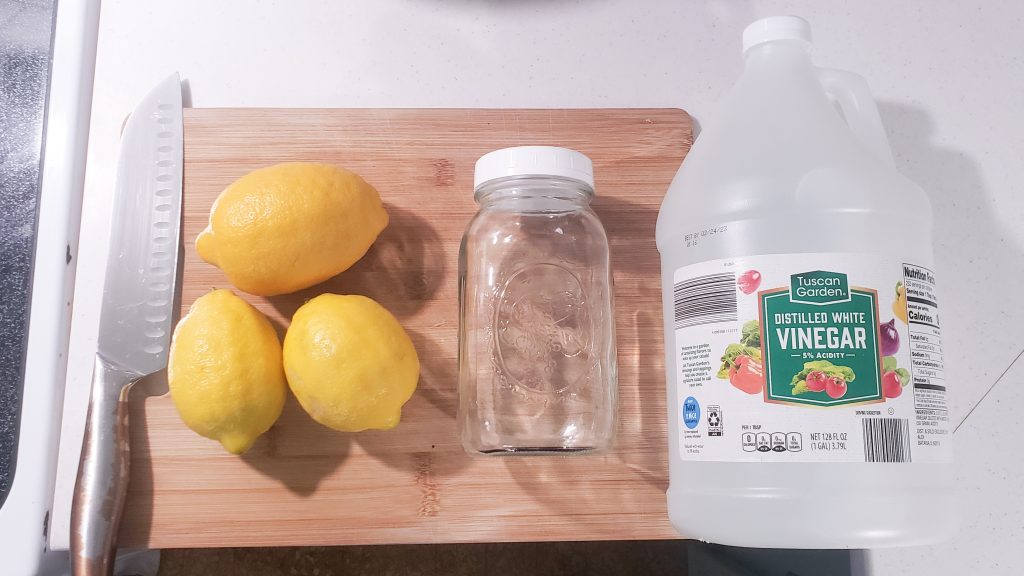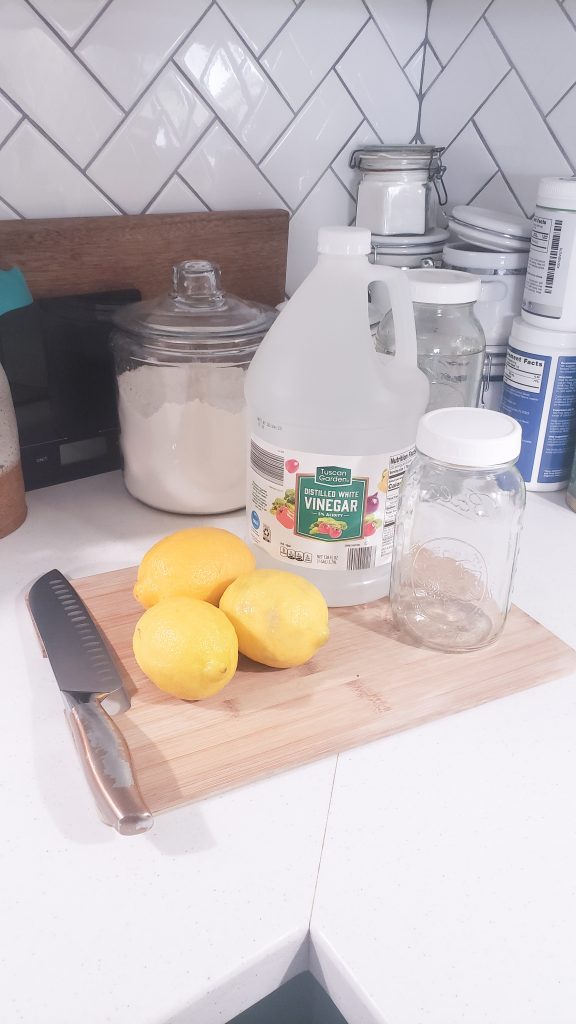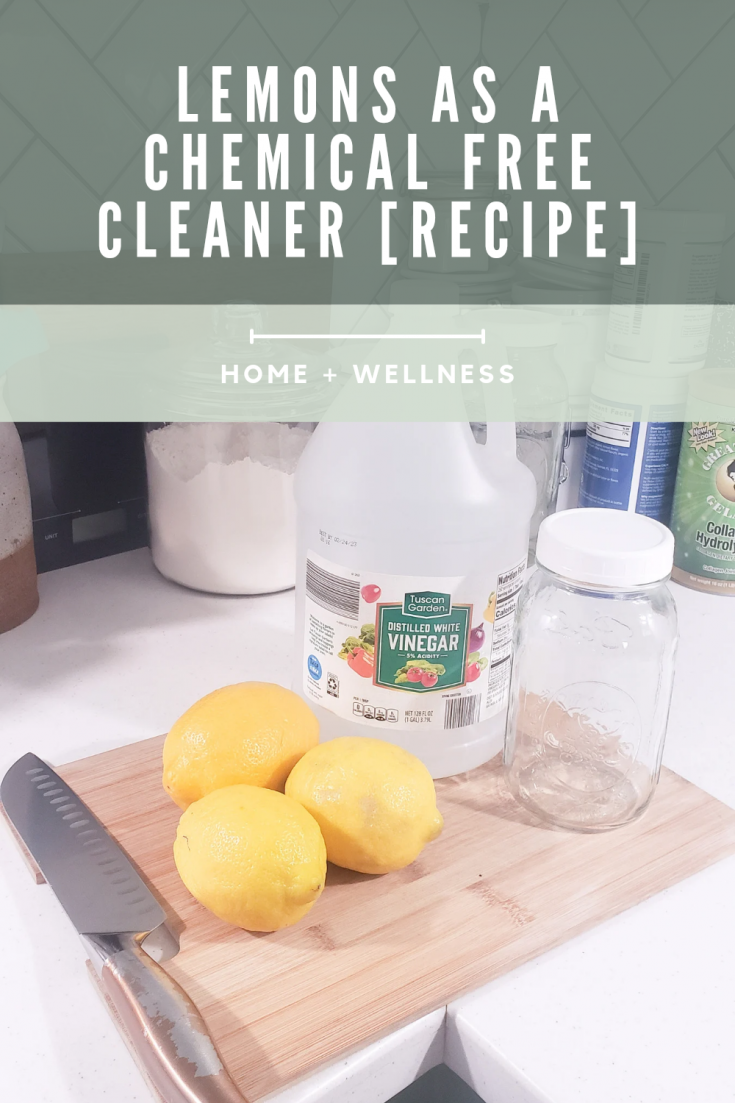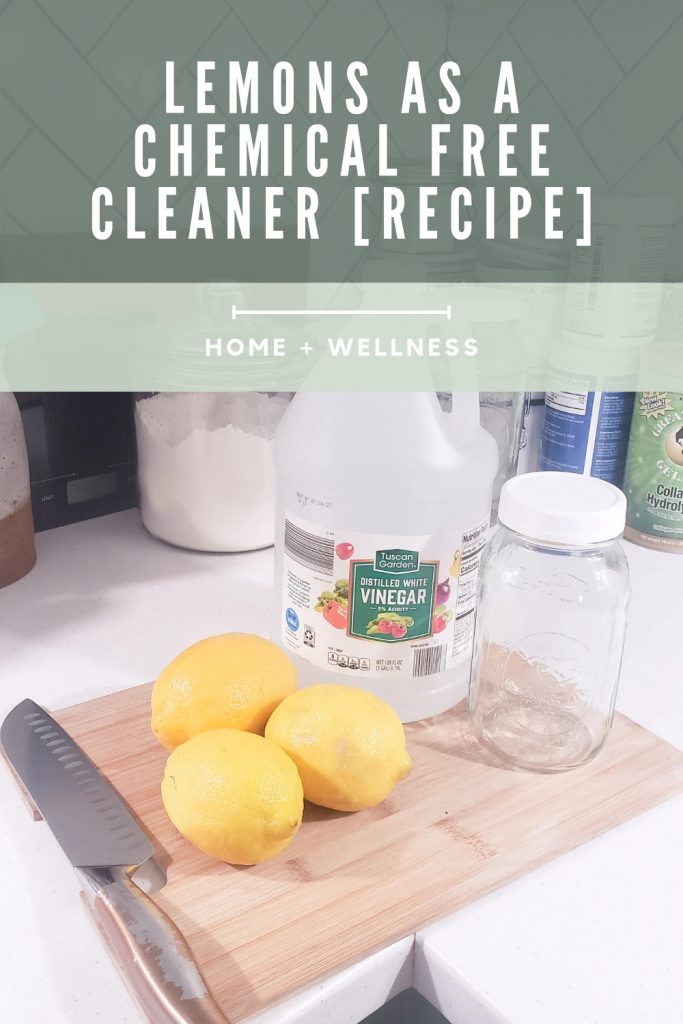Have you ever wondered how or why some people use lemon rinds for cleaning? Here are some quick facts and answers about using lemon as a cleaning product. Plus a recipe for vinegar and lemon as a chemical free cleaner.

Doing the research
I’ve long been interested in how to use lemons as a chemical free cleaner. So I started by looking into what exactly lemons do to clean. Briefly searching the internet for lemon’s cleaning properties leads readers to claims of being antibacterial and antimicrobial. But very few of these claims refer back to any kind of specific research or studies.
However, there was a study I found whose purpose was to determine if the use of lemon on skin diseases and ailments in third world countries had any real efficacy. This study did in fact determine scientifically that there are antibacterial properties in the juices and oils of lemons.
So if it works to cure skin diseases, it isn’t really surprising that we can use lemons for similar cleaning capabilities. Just remember that “antibacterial” does not mean the same thing as “disinfectant” so there are still many cleaning scenarios where lemons are insufficient.
What can lemons be used to clean?
There are many uses for lemons as a chemical free cleaner. They are great for descaling coffee carafes, removing stains from marble, ceramics, and even plastics, and as an antibacterial wash on things like cutting boards. They can also be used to return a shine to stainless steel cookware by applying lemon and then buffing with a towel.
Lemons are also great stain removers on other household items outside the kitchen, such as removing a child’s drawing from a painted wall, or removing sharpie price tags from thrift store purchases.
How does it work?
One of the main contributors to how lemons work for cleaning is their acidity, similarly to how some vinegars can be used for cleaning. The acid content “eats” away at bacteria, buildups, or artificial markings. Lemon rinds can be used directly to clean things. You can also squeeze lemon juice into hot water to soak things, or add sliced lemon to vinegar to create cleaning solutions that you can bottle. (Check out the link below in the community section for just one way to do this.)
Why should I use lemon instead of other products?
My favorite benefit of using lemon juice or rinds for cleaning is simply that they do not contain other unknown and unfavorable chemicals that can have hidden effects on our possessions and most importantly on our health. Using lemons is an all natural way to clean without using harsh chemicals, and it has the added benefit of being cheap, sustainable, and compostable in the end. Using lemons for cleaning is also why so many cleaning chemicals are citrus-scented – because the smell of lemon has long been associated with cleanliness.
Do lemon essential oils work the same way?
In short, the benefits of lemon oil is largely based on how it was distilled and what it is suspended in. Each major essential oils company swears that their oil is the purest and has the most efficacy. Many demonstrably have wonderful cleaning powers, some even more than using a single lemon due to the concentration of the oil. So if you’re going to use lemon essential oils for cleaning (or cooking or health and wellness benefits) make sure that you are using a reputable company that uses clean practices for creating their essential oils. And also be prepared to spend a good deal more than you would on simply purchasing lemons.

Lemon and Vinegar Cleaning Solution Recipe
I decided to go with a very simple recipe for a lemon cleaner. This particular recipe is the easiest I’ve found for using lemons as a chemical free cleaner aside from using a lemon directly. You need two ingredients, a mason jar, and about one to two weeks to allow it to “brew”.
Ingredients:
- lemon rinds or whole unused lemons
- white distilled vinegar
The steps are just as simple as the ingredients.
I didn’t have lemon rinds on hand and it’s fairly uncommon that I do, so I started with three large whole lemons. I cut them into slices and hand squeezed a bunch of the juice into a glass for food and drink uses, and put it in the refrigerator.
Leaving plenty of the juice and all of the pulpy insides, I crammed as many lemon pieces as I could into a mason jar, and then poured the vinegar over the top. I made sure to cover as much of the surface area of rinds as possible, so basically right up to brimming full. I didn’t use a metal jar lid because of the high acidity, but opted for a plastic non sealing cap.
Then I left it on a shelf for two weeks for the vinegar to pull all the good things out of the lemons. Every few days I’d shake the bottle to help that out, but who knows if that is necessary or effective.
After about two weeks (or longer if you want) you can simply pour off the vinegar and strain out any seeds or pulp that may remain from the lemons. I squeezed the lemons out a bit more at this point as well.
Put your new cleaning solution into a glass jar or bottle, preferably with a spray top if you have that, and label it so you know what it is. Believe it or not, your lemon vinegar cleaning solution is now ready to use!
I read that this should be stored at cool room temps and out of direct sunlight, so that is what I will try to do as well.
Lemon Vinegar Cleaning Solution

This lemon vinegar cleaning solution is both a antibacterial degreaser, and it's chemical free!
Materials
- lemon rinds or whole lemons sliced up
- white distilled vinegar
Tools
- glass jar
- glass bottle with spray top
Instructions
- I didn't have lemon rinds on hand and it's fairly uncommon that I do, so I started with three large whole lemons. I cut them into slices and hand squeezed a bunch of the juice into a glass for food and drink uses, and put it in the refrigerator.
- Leaving plenty of the juice and all of the pulpy insides, I crammed as many lemon pieces as I could into a mason jar, and then poured the vinegar over the top. I made sure to cover as much of the surface area of rinds as possible, so basically right up to brimming full. I didn't use a metal jar lid because of the high acidity, but opted for a plastic non sealing cap.
- Then I left it on a shelf for two weeks for the vinegar to pull all the good things out of the lemons. Every few days I'd shake the bottle to help that out, but who knows if that is necessary or effective.
- After about two weeks (or longer if you want) you can simply pour off the vinegar and strain out any seeds or pulp that may remain from the lemons. I squeezed the lemons out a bit more at this point as well.
- Put your new cleaning solution into a class jar or bottle, preferably with a spray top if you have that, and label it so you know what it is. Believe it or not, your lemon vinegar cleaning solution is now ready to use!
Notes
I read that this should be stored at cool room temps and out of direct sunlight, so that is what I will try to do as well.
Community
A quick search around the internet helped me find a good method for making this type of cleaner. I got a lot of info over on Deanna’s blog Homestead and Chill.

